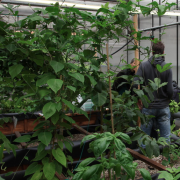Aquaponics: Material flow aquarium
Background
An essential point of the Blue Economy is to interlace multiple material flows to create added value. In agriculture, it is possible to do so in the most natural way. It is hardly surprising that some of the most important „Blue“ projects are found in this area; these are called „Integrated Farming“.
Biodiversity and the use of different kingdoms of nature (plants, protists, bacteria, fungi and animals) are the main focus: a farm produces biogas, pigs, algea, fishes and different sorts of vegetables – all that on a pretty small area.
Here it is how it works:
Pigs are producing manure, from which biogas is produced. Biogas delivers the energy needed to make a various number of processes. On the remaining waste mushrooms are bred.
The pig’s urine is used to grow seaweeds, and these seaweeds are used as a way to clean water. The clean water is then used as a base to breed fish. The water from the fish is also used as manure for the fields and for the vegetable production. This organic „waste“ is also used to grow the mushroom. Ultimately we have a high quality humus, filled with worms. And the worms are perfectly fit for feeding the fishes.
In those kinds of systems, it is possible to add a lot of elements: mulberries can be used both to produce silk and as a hedge; fish ponds can also be used as rice paddies; worms and maggots can compost waste and serve as food for the animals, and the list goes on.
If agriculture is considered this way, it can be free of almost every pesticides and genetically modified seeds – it builds up a biological system with a high biodiversity and high-yield crops.
In the 1960s and the 70s a first wave of „aquaponic-systems“ developed, in such systems fishes and plants are grown together in a greenhouse. Fishes are providing the plants with nutrients, especially nitrogen, and the plants are cleaning the water for fishes. The water is laid in a closed loop and the production can take place all year round thanks to the warmth of the greenhouse.
However, most of those systems are producing tomatoes and salads in monoculture in combination with tilapia to get a maximal yield. Until now, aquaponics is primarily developed in the USA and Australia.
Do It Yourself
But even if you are not a farmer, you can apply the „blue principles“ of integrated farming and aquaponics at home. A little aquarium built with common materials is pretty to watch and useful at the same time. Basil, chives and tomatoes, functioning as a biological filter, can be easily grown in the system.
TopFarmers created a construction manual which is available on open-source and that you can find here: http://www.blueeconomy.de/m/files/view/Mini-Aquaponics-Manual.
Potential
From this idea, BTTR Ventures, an american company, created an all in-one fish tank from which you can grow plants, the „AquaFarm“. It can be ordered online for 60$. The company used a kicksarter campaign to raise 250.000$ in order to produce the first kits. It may be then possible to sell seeds regularly to the customers, in the form of a monthly package for instance.
In any case, a aquaponic-aquarium is good to provide an understanding of how an ecosystem works, kids will especially understand it very quickly. It is nice way to use the principle of the Blue Economy in our every day life, at home – and at the same time, to always have fresh herbs and healthy greens at hand.

